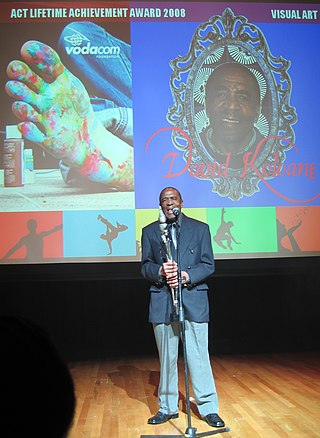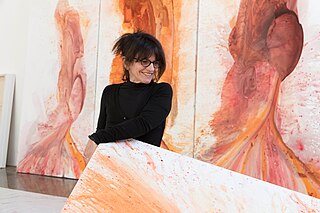Related Research Articles

South African art is the visual art produced by the people inhabiting the territory occupied by the modern country of South Africa. The oldest art objects in the world were discovered in a South African cave. Archaeologists have discovered two sets of art kits thought to be 100,000 years old at a cave in South Africa. The findings provide a glimpse into how early humans produced and stored ochre – a form of paint – which pushes back our understanding of when evolved complex cognition occurred by around 20,000 – 30,000 years. Also, dating from 75,000 years ago, they found small drilled snail shells could have no other function than to have been strung on a string as a necklace. South Africa was one of the cradles of the human species.
David Goldblatt HonFRPS was a South African photographer noted for his portrayal of South Africa during the period of apartheid. After apartheid had ended he concentrated more on the country's landscapes. What differentiates Goldblatt's body of work from those of other anti-apartheid artists is that he photographed issues that went beyond the violent events of apartheid and reflected the conditions that led up to them. His forms of protest have a subtlety that traditional documentary photographs may lack: "[M]y dispassion was an attitude in which I tried to avoid easy judgments. . . . This resulted in a photography that appeared to be disengaged and apolitical, but which was in fact the opposite." He has numerous publications to his name.

William Kentridge is a South African artist best known for his prints, drawings, and animated films, especially noted for a sequence of hand-drawn animated films he produced during the 1990s. The latter are constructed by filming a drawing, making erasures and changes, and filming it again. He continues this process meticulously, giving each change to the drawing a quarter of a second to two seconds' screen time. A single drawing will be altered and filmed this way until the end of a scene. These palimpsest-like drawings are later displayed along with the films as finished pieces of art.
Lwandle/Nomzamo is a small township in the Helderberg basin just outside Strand in the Western Cape of South Africa. Both names are sometimes used interchangeably referring to both places. This may be attributed to the fact that Nomzamo was born as a result of overpopulation in Lwandle area which initially designed as a cheap accommodation for "single male workers" during the apartheid years.
Berni Searle is an artist who works with photography, video, and film to produce lens-based installations that stage narratives connected to history, identity, memory, and place. Often politically and socially engaged, her work also draws on universal emotions associated with vulnerability, loss and beauty.
Gavin Jantjes is a South African painter, curator, writer and lecturer.
Buysile "Billy" Mandindi (1967–2005) was a black South African activist-artist who participated in a landmark protest in Cape Town in 1989, the so-called Purple Rain Protest. Later, still covered with the purple dye that riot police sprayed on protesters, Mandindi created a linocut celebrating the spirit of freedom.

Romuald Hazoumè is a Yoruba artist and sculptor, from the Republic of Bénin.
Peter Clarke was a South African visual artist working across a broad spectrum of media. He was also a writer and poet.

Amitabh Mitra is an Indian-born South African physician, poet and artist, whose paintings depict dramatised stick figures.

David Nthubu Koloane was a South African artist. In his drawings, paintings and collages he explored questions about political injustice and human rights. Koloane is considered to have been "an influential artist and writer of the apartheid years" in South Africa.

Esther Mahlangu is a South African artist. She is known for her bold large-scale contemporary paintings that reference her Ndebele heritage. She is one of South Africa's best known artists.
Athi-Patra Ruga is a South African artist who uses performance, photography, video, textiles, and printmaking to explore notions of utopia and dystopia, material and memory. His work explores the body in relation to sensuality, culture, and ideology, often creating cultural hybrids. Themes such as sexuality,Xhosa culture, and the place of queerness within post-apartheid South Africa also permeate his work.
The Community Arts Project (CAP) was a community arts center in Cape Town, South Africa. Founded in 1977. it provided accommodation, facilities, and training to aspiring artists, particularly those marginalised by apartheid.
The Montagu Museum is a museum of Montagu, Western Cape
Mary Sibande is a South African artist based in Johannesburg. Her art consists of sculptures, paintings, photography, and design. Sibande uses these mediums and techniques to help depict the human form and explore the construction of identity in a postcolonial South African context. In addition, Sibande focuses on using her work to show her personal experiences through Apartheid. Her art also attempts to critique stereotypical depictions of women, particularly black women.
Jane Alexander is one of the most celebrated artists in South Africa. She is a female artist best known for her sculpture, The Butcher Boys. She works in sculpture, photomontages, photography and video. Alexander is interested in human behavior, conflicts in history, cultural memories of abuse and the lack of global interference during apartheid. Alexander's work is relevant both in the current Post- Apartheid social environment in South Africa and abroad.

Penny Siopis is a South African artist from Cape Town. She was born in Vryburg in the North West province from Greek parents who had moved after inheriting a bakery from Siopis maternal grandfather. Siopis studied Fine Arts at Rhodes University in Makhanda, completing her master's degree in 1976, after which she pursued postgraduate studies at Portsmouth Polytechnic in the United Kingdom. She taught Fine Arts at the Technikon Natal in Durban from 1980 to 1983. In 1984 she took up a lectureship at the University of the Witwatersrand in Johannesburg. During this time she was also visiting research fellow at the University of Leeds (1992–93) and visiting professor in fine arts at Umeå University in Sweden (2000) as part of an interinstitutional exchange. With an honorary doctorate from Rhodes University, Makhanda – Siopis is currently honorary professor at Michaelis School of Fine Art, University of Cape Town.

Zwelidumile Geelboi Mgxaji Mhlaba "Dumile" Feni was a South African contemporary visual artist known for Katlego Lhuzwayoboth his drawings and paintings that included sculptural elements as well as sculptures, which often depicted the struggle against Apartheid in South Africa. Feni lived in exile and extreme poverty for most of his art career.
Bongiwe or Bongi Dhlomo-Mautloa, is a Zulu South African printmaker, arts administrator and activist.
References
- ↑ "Willie Bester". South African History Online. Retrieved 7 November 2019.
- 1 2 Ross, Doran (1995). "On Art and Museums in South Africa after the Elections". African Arts. 28 (1): 1–7. doi:10.2307/3337242. JSTOR 3337242.
- 1 2 "Willie Bester". The Presidency Government of South Africa. Retrieved 7 November 2019.
- 1 2 3 4 5 6 7 8 9 10 11 12 13 14 Godby, Michael; Klopper, Sandra (1996). "The Art of Willie Bester". African Arts. 29 (1): 42–49. doi:10.2307/3337446. JSTOR 3337446.
- ↑ Konate, Yacouba (1998). "Willie Bester: Engagé Et Engageant". Cimaise. 4 (253): 81–87.
- ↑ Godby, Michael (2007). Is There Still Life? Continuity and Change in South African Still Life Painting. Publ. to Accompany the Exhibition at the Old Town House, Cape Town and at the Sanlam Art Gallery, Bellville, 2007 and 2008.
- ↑ McIntosh, Tavish (2009). "Reviewed work: Is There Still Life? Continuity and Change in South African Still Life Painting by Michael Godby". African Arts. 42 (1): 109–110. doi:10.1162/afar.2009.42.1.109. JSTOR 20447946. S2CID 127188371.
- 1 2 Powell, Ivor (2018). "Behind UCT's Removed Art: The Writing on the Wall". Journal of Intellectual Freedom and Privacy. 2 (3–4): 7–12. doi: 10.5860/jifp.v2i3-4.6412 .
- 1 2 de Jong, Anneleen (2000). "Portraying a Story: The Narrative Function of the Human Form in Contemporary Art of South Africa". Research in African Literatures. 31 (4): 125–138. doi:10.2979/RAL.2000.31.4.125. JSTOR 3821082. S2CID 162217844.
- 1 2 Maphanga, Canny. "UKZN Pays Tribute to Resistance Artist Willie Bester for Life's Work". News24. Retrieved 7 November 2019.
- ↑ Hill, Shannen (1999). "Reviewed Work: Thirty Minutes: Installations by Nine Artists". African Arts. 32 (2): 76–77. doi:10.2307/3337606. JSTOR 3337606.
- ↑ Hoxworth, Kellen (2017). "The Many Racial Effigies of Sara Baartman". Theatre Survey. 58 (3): 275–299. doi:10.1017/S0040557417000254.
- ↑ "Willie Bester - Pigozzi Collection 2019". CAACART - The Pigozzi Collection. Retrieved 12 November 2019.